



















|
 |
|
 |

The Sweboz' warriors & fighting tactics resemble that of its Celtic neighbours. Infantry is the mainstay and they charge towards the enemy in a big 'warband'. However, unlike the Celts who might break, the Sweboz will instead disengage should this charge be halted, and invent a new plan for fighting. The Sweboz also have good cavalry and can give the enemy a nasty surprise should they underestimate them.
The current list shows factional units as well as regional units from the surrounding provinces of the Sweboz kingdom. These are not the only troops available to the Sweboz and other troop types will be available should the Sweboz expand out of Germania. For possible regionals check the Eleutheroi unit pages.
Gaizoz Frije (Germanic Levy Spearmen)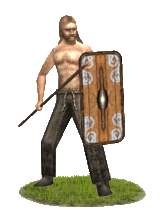 Gaizoz Frije ("One's own Spears"), whose name also means "Free Spears" are composed largely of local farmers and hunters, Germanic "free" men of the lowest rank, accustomed to frequent raids and tribal warfare from a young age. According to Germanic tradition, as soon as these men receive their gaizaz (spear) and skelduz (shield), they are frije ("free") adults, charged with equal shares and responsibilities in the tribe. Frije also came to mean "one's own," for to belong was to fulfill those duties of being "free." Gaizoz Frije ("One's own Spears"), whose name also means "Free Spears" are composed largely of local farmers and hunters, Germanic "free" men of the lowest rank, accustomed to frequent raids and tribal warfare from a young age. According to Germanic tradition, as soon as these men receive their gaizaz (spear) and skelduz (shield), they are frije ("free") adults, charged with equal shares and responsibilities in the tribe. Frije also came to mean "one's own," for to belong was to fulfill those duties of being "free."
Historically every "free" man of the Germanic tribes was a warrior, and expected to serve frequently in such a capacity. Though lacking in the organized training of the warbands that serve in a more regular capacity, these men are veterans of the ritualized tribal warfare within the amalgamation of German tribes, and fight with a force and fury superior to their neighbors’ militia.
Jugunthiz (Germanic Skirmishers)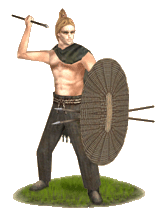 The Jugunthiz ("Youth") is a unit of lightly armed skirmisher troops who break up and harass enemy formations before the main battle lines meet, and act as a screen for heavy troops, taking losses in order to increase the odds of survival of more valuable "proven" warriors (Dugunthiz) who stand just behind. They must first prove themselves in battle in order to earn experience and status and fight beside their betters. Their skills also make them useful in springing tactical ambushes. Each warrior is armed with a bundle of throwing spears, a slightly longer spear for melee and a stout ovular shield, but they do not wear armor, being poor and of low status, but also choosing speed over protection. The Jugunthiz ("Youth") is a unit of lightly armed skirmisher troops who break up and harass enemy formations before the main battle lines meet, and act as a screen for heavy troops, taking losses in order to increase the odds of survival of more valuable "proven" warriors (Dugunthiz) who stand just behind. They must first prove themselves in battle in order to earn experience and status and fight beside their betters. Their skills also make them useful in springing tactical ambushes. Each warrior is armed with a bundle of throwing spears, a slightly longer spear for melee and a stout ovular shield, but they do not wear armor, being poor and of low status, but also choosing speed over protection.
Historically, the Jugunthiz are composed of a tribe’s young and inexperienced warriors. These men had yet to prove themselves as warriors, having had little practice in close combat, but like all Germanic warriors were eager to gain honor in the face of battle, and more steady skirmishers for it.
Dugunthiz (Germanic Spearmen)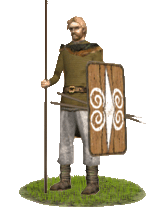 The Dugunthiz (the "Trusted" or "Capable" ones) is a unit of proud and experienced, "proven" warriors steeled by years of constant warfare and veterans of numerous conflicts, mostly tribal, but some of a larger scale. These men are hardened for battle and unlikely to flee from conflict, and are trained through long experience to work in close or open formation, and even the shieldwall. The Dugunthiz (the "Trusted" or "Capable" ones) is a unit of proud and experienced, "proven" warriors steeled by years of constant warfare and veterans of numerous conflicts, mostly tribal, but some of a larger scale. These men are hardened for battle and unlikely to flee from conflict, and are trained through long experience to work in close or open formation, and even the shieldwall.
Historically, the Jugunthiz (Youth) formed the front line of battle in order to act as a screen, taking losses to increase the odds of survival for more valuable "proven" warriors (Dugunthiz) who stood just behind. The Dugunthiz formed the bulk of any Germanic force and were very versatile warriors. They were renowned for their courage in melee combat and have earned their place through consummate skill with their well accustomed gaizaz (spear). Their weapon is a mark of freedom and honor, the gaizaz has a narrow and short head, so sharp and easy to wield that the same weapon served, depending on the circumstances, for both close quarter and long range combat.
Slaganz (Germanic Club Infantry)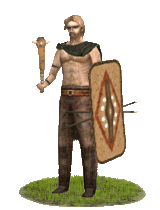 Slaganz ("Strikers"), whose name also means "Slayers" are Germanic warriors who specifically choose a cudgel for close combat in order to cause massive and deadly blunt force trauma. Even if they might not be able afford metal weapons of higher status, Germanic warriors are typically able to make effective arms quickly from any readily available materials. Slaganz ("Strikers"), whose name also means "Slayers" are Germanic warriors who specifically choose a cudgel for close combat in order to cause massive and deadly blunt force trauma. Even if they might not be able afford metal weapons of higher status, Germanic warriors are typically able to make effective arms quickly from any readily available materials.
By shaping heavy boughs of oak and inserting bone spikes, this special weapon can be used to maim both armored and unarmored foes alike. Cudgels are cheap, easy to make, and replaceable on campaign, while also being able to smash or punch through armor. Although this weapon may seem primitive to untrained eyes, against armored opponents it is more effective than any other at disposal.
Historically, the Germanic tribes quickly realized they naturally lacked the resources required to outfit their men with the armor seen in surrounding societies and found themselves often resorting to weapons with the specific purpose of crushing armor in order to achieve victory over better equipped foes. This worked with a great deal of success as seen by use of these warriors by the Roman Army in their auxilia, depicted on Trajan's Column as possessing swords but choosing to wield clubs. These light armored club warriors were recorded to have taken down units of the feared and notoriously lethal kataphraktoi.
Skutjanz (Germanic Archers)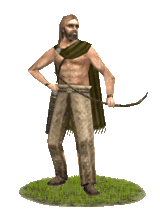 Skutjanz ("Shooters"), whose name also means "Marksmen" are equipped to harass and break up enemy formations so more experienced and valuable melee warriors can get in amongst their thinned ranks and finish them. Skutjanz are often untrained or uncapable warriors who guard the baggage train, but many are also excellect hunters or Germanic freemen of the lowest rank who cannot afford training or equipment. Skutjanz are also armed with the typical Germanic spear, which means that they can do a little more than other units of similar type in hand-to-hand combat and can act as light infantry in times of need. Their presence on a battlefield is always useful, as they have the flexibility to be both archers and infantry, but they will not last long in melee battle against opponents with superior training and protection. Skutjanz are at their best in wooded country, where their superior ambush skills, learned on the hunt, can be put to best use. Skutjanz ("Shooters"), whose name also means "Marksmen" are equipped to harass and break up enemy formations so more experienced and valuable melee warriors can get in amongst their thinned ranks and finish them. Skutjanz are often untrained or uncapable warriors who guard the baggage train, but many are also excellect hunters or Germanic freemen of the lowest rank who cannot afford training or equipment. Skutjanz are also armed with the typical Germanic spear, which means that they can do a little more than other units of similar type in hand-to-hand combat and can act as light infantry in times of need. Their presence on a battlefield is always useful, as they have the flexibility to be both archers and infantry, but they will not last long in melee battle against opponents with superior training and protection. Skutjanz are at their best in wooded country, where their superior ambush skills, learned on the hunt, can be put to best use.
Historically, Germanic bowmen on the battlefield were few in numbers, because weapons were status symbols and tools whose exclusive purpose was for war required more wealth and training than common multipurpose tools, such as the axe or bow. Yet all Germanic warriors were potential Skutjanz ("Marksmen"), having mastered hunting skills in dense and dark Germanic forests where their learned techniques of skulking and stalking serve them well. The Skutjanz use hunting bows which have only a short range, but each carries a good selection of hunting arrows, as well as war arrows, designed to cause massive bleeding and pierce armor respectively.
Herunautoz (Germanic Swordsmen)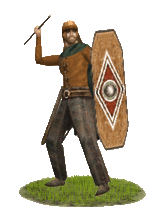 The Herunautoz ("Sword-possessors") come from such warlike tribes as the Heruskoz, Habukoz, Hattoz, and other numerous tribes of the Swęboz confederation. They are well trained, experienced and armed with superior quality swords and javelins to soften the enemy before their furious charge. The Herunautoz ("Sword-possessors") come from such warlike tribes as the Heruskoz, Habukoz, Hattoz, and other numerous tribes of the Swęboz confederation. They are well trained, experienced and armed with superior quality swords and javelins to soften the enemy before their furious charge.
Historically, swords were not plentiful in Germanic lands, because of the cost of the iron needed for a such a weapon, and so those fierce and valiant warriors carried their highly valued swords with pride. They fought in dense formations, often with their own kinsmen at their side. Often these warriors were aligned to the war-god Tiwaz as the sword was not only a weapon of esteem and regard for the Germanic tribes but also often used in religious ceremonies.
Skaduganganz (Germanic Naked Spearmen)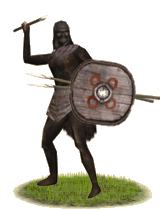 Skaduganganz ("Night-Walkers"), whose name also means "Shadow-goers" are unconventional warriors from the East who specialize in ambush. They display their zeal and innate ferocity with the help of pitch and dye by blackening their shields and bodies. They choose pitched nights for their battles and strike fear into the hearts of their enemies with the terrifying, "shadow"-like appearance of an army of the dead. When the moment is right, they charge wildly, wide-eyed and screaming at their foes. Any who survive assaults by these maniacal warriors are convinced they are spirits sent from the otherworld. Skaduganganz ("Night-Walkers"), whose name also means "Shadow-goers" are unconventional warriors from the East who specialize in ambush. They display their zeal and innate ferocity with the help of pitch and dye by blackening their shields and bodies. They choose pitched nights for their battles and strike fear into the hearts of their enemies with the terrifying, "shadow"-like appearance of an army of the dead. When the moment is right, they charge wildly, wide-eyed and screaming at their foes. Any who survive assaults by these maniacal warriors are convinced they are spirits sent from the otherworld.
Historically, Tacitus mentions this unqiue practice was used by a group called the Hariz (Harii), whose name means "Harrying ones" in their own language.
Ridanz (Germanic Light Cavalry)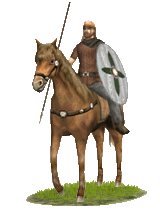 Ridanz ("Riders") ride small and sometimes poor quality horses, though they are excellent light cavalry. They are useful as scouts as well as skirmishers. Like many Germanic warriors, however, they can lack battle-discipline and be over-keen to enter battle against worthy opponents. This can lead them to be headstrong, and difficult to restrain before a fight, as personal glory gained in battle is always welcome. Honor and standing come from fighting, and sometimes the urge for glory overwhelms their good sense! Ridanz ("Riders") ride small and sometimes poor quality horses, though they are excellent light cavalry. They are useful as scouts as well as skirmishers. Like many Germanic warriors, however, they can lack battle-discipline and be over-keen to enter battle against worthy opponents. This can lead them to be headstrong, and difficult to restrain before a fight, as personal glory gained in battle is always welcome. Honor and standing come from fighting, and sometimes the urge for glory overwhelms their good sense!
Historically, Germanic tribes did not frequently use cavalry and their warriors mainly fought on foot, however, some tribes were known for their use of cavalry and many peoples praised the good quality of Germanic cavalry. Though the horses that were used by the Germanic tribes were not exceptional, Germanic horsemen could still maneuver very well and operated as a unit, rather than as an unorganized band.
These early Germanic horsemen did not use saddles by choice, nor stirrups because they were unknown in Europe at that time, later introduced by invading peoples from the east. The Germanic tribes were among the first peoples to copy the stirrup because they recognized its potential, for with a stirrup the warrior could not only mount his horse more easily but he could also "step up" on his horse to throw a spear. They were mostly armed with shield and spear and were supported by fast-moving light infantry - this light cavalry combined with light infantry allowed great tactical speed and versatility on the battlefield; the cavalry could break through enemy lines while the infantry quickly followed behind to finish off any remaining enemy soldiers.
Speutagardaz (Germanic Pikemen)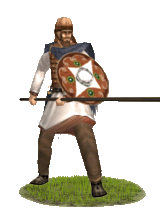 The Speutagardaz ("Pike-fence") is a unit of hard-nosed, disciplined warriors that fight together in a very dense formation, unlike most other Germanic warbands. During their years of constant battle with hostile nations, they've developed new strategies for combat and defense, and learned early to form an impenetrable burdahagon ("shield-wall") to repel their attackers. Their chosen weapon, the speutan (pike) is a deadly and intimidating weapon with a long spearhead, which makes these warriors capable of punching through almost any type armor from great distances, and are universally feared for their abilities against cavalry formations. The Speutagardaz ("Pike-fence") is a unit of hard-nosed, disciplined warriors that fight together in a very dense formation, unlike most other Germanic warbands. During their years of constant battle with hostile nations, they've developed new strategies for combat and defense, and learned early to form an impenetrable burdahagon ("shield-wall") to repel their attackers. Their chosen weapon, the speutan (pike) is a deadly and intimidating weapon with a long spearhead, which makes these warriors capable of punching through almost any type armor from great distances, and are universally feared for their abilities against cavalry formations.
Historically, the Speutagardaz naturally developed through native innovation as spear and shield tactics were refined. Their pikes were adapted to the armor and the cavalry tactics of numerous enemies. They array their spears and shields in a "fence"-like forest of death, supplying them perfect protection as their strong pikes reach out and menace the approaching forces. The Germanic pike (speutan) was a deadly weapon with a long, 40 to 45 cm spearhead. In texts of historical warfare, they are always called 'enormous' or 'over-long' (prealonga hastas).
Thegnoz Drugule (Germanic Heavy Infantry)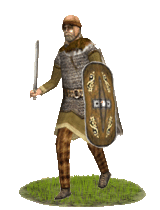 Thegnoz Drugule ("Mercenary Thanes"), often called herthaganautoz ("hearth-companions") by their lord, are the Germanic tribes' best warriors. A war-leader is obeyed by his warriors because of his bravery, not because of his rank. In battle he must act as an example to his men and it is a disgrace for him to be surpassed by them in bravery. The warriors in turn have to equal the bravery of their war-leader. The lord fights for victory, his companions for their lord. Thegnoz are fearless, and even hungrier for glory than younger men. Their original training has been augmented by years of warfare, often leaving their bodies heavily scarred. Thegnoz are wealthy, powerful men, fiercely loyal to their lord. Their weapons and armor are the best, because these warriors have joined the retinue of a chieftain or other powerful lord who often provides better equipment. Thegnoz Drugule ("Mercenary Thanes"), often called herthaganautoz ("hearth-companions") by their lord, are the Germanic tribes' best warriors. A war-leader is obeyed by his warriors because of his bravery, not because of his rank. In battle he must act as an example to his men and it is a disgrace for him to be surpassed by them in bravery. The warriors in turn have to equal the bravery of their war-leader. The lord fights for victory, his companions for their lord. Thegnoz are fearless, and even hungrier for glory than younger men. Their original training has been augmented by years of warfare, often leaving their bodies heavily scarred. Thegnoz are wealthy, powerful men, fiercely loyal to their lord. Their weapons and armor are the best, because these warriors have joined the retinue of a chieftain or other powerful lord who often provides better equipment.
Historically, each frawjon (lord) had a retinue of followers, Thegnoz who were linked to him by personal loyalty. To leave a battlefield alive while their lord lay dead meant a life of shame and scorn for such men. To defend and protect him, to assign one's own acts of heroism to his credit- that's what is truly meant by ‘allegiance.’ These warriors have sworn oaths upon the mead-bench to stay loyal to their frawjon and to protect him with their lives if needed, and in return he has sworn to support them and their families, to provide them with food, drink, weapons and equipment in exchange for the fulfillment of their vows and deeds in his service.
Marhathegnoz (Germanic Heavy Cavalry)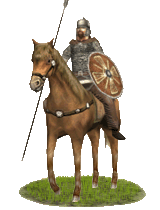 Marhathegnoz ("Warhorse-thanes"), whose name also means "Companion Cavalry" are a heavy cavalry unit composed of the Germanic tribes' best warriors, by foot or horseback. Those Thegnoz have joined the retinue of a chieftain or other powerful lord who can provide them with the finest Celtic warhorses and wargrear at his disposal. Their original training has been augmented by years of warfare gaining glory and wealth through battle prowess and weapon skill. They are extremely wealthy and powerful men, but still fiercely loyal to their lord who brings them victory. Marhathegnoz ("Warhorse-thanes"), whose name also means "Companion Cavalry" are a heavy cavalry unit composed of the Germanic tribes' best warriors, by foot or horseback. Those Thegnoz have joined the retinue of a chieftain or other powerful lord who can provide them with the finest Celtic warhorses and wargrear at his disposal. Their original training has been augmented by years of warfare gaining glory and wealth through battle prowess and weapon skill. They are extremely wealthy and powerful men, but still fiercely loyal to their lord who brings them victory.
Marhathegnoz can be used most effectively as shock troops whose charges can break the enemy line and destory their flanks, but they are also useful for overrunning heavy infantry and slaughtering lighter cavalry.
Historically, Germanic tribes did not frequently use cavalry and their warriors mainly fought on foot, however, some tribes were known for their use of cavalry and many peoples praised the good quality of Germanic cavalry. Germanic horsemen did not use saddles by choice, nor stirrups because they were unknown in Europe at that time, later introduced by invading peoples from the east. The Germanic tribes were among the first peoples to copy the stirrup because they recognized its potential, for with a stirrup the warrior could not only mount his horse more easily but he could also "step up" on his horse to throw a spear.
Herthaganautoz (Germanic Bodyguard Infantry)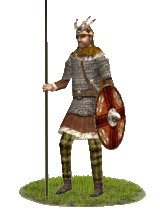 Herthaganautoz ("Hearth-Companions"), often called thegnoz ("thanes") in a general sense, are the Germanic tribes' best warriors. A war-leader is obeyed by his warriors because of his bravery, not because of his rank. In battle he must act as an example to his men and it is a disgrace for him to be surpassed by them in bravery. The warriors in turn have to equal the bravery of their war-leader. The lord fights for victory, his companions for their lord. Herthaganautoz are fearless, and even hungrier for glory than younger men. Their original training has been augmented by years of warfare, often leaving their bodies heavily scarred. Herthaganautoz are wealthy, powerful men, fiercely loyal to their lord. Their weapons and armor are the best, because these warriors have joined the retinue of a chieftain or other powerful lord who often provides better equipment. Herthaganautoz ("Hearth-Companions"), often called thegnoz ("thanes") in a general sense, are the Germanic tribes' best warriors. A war-leader is obeyed by his warriors because of his bravery, not because of his rank. In battle he must act as an example to his men and it is a disgrace for him to be surpassed by them in bravery. The warriors in turn have to equal the bravery of their war-leader. The lord fights for victory, his companions for their lord. Herthaganautoz are fearless, and even hungrier for glory than younger men. Their original training has been augmented by years of warfare, often leaving their bodies heavily scarred. Herthaganautoz are wealthy, powerful men, fiercely loyal to their lord. Their weapons and armor are the best, because these warriors have joined the retinue of a chieftain or other powerful lord who often provides better equipment.
Historically, each frawjon (lord) had a retinue of followers, the Herthaganautoz who were linked to him by personal loyalty. To leave a battlefield alive while their lord lay dead meant a life of shame and scorn for such men. To defend and protect him, to assign one's own acts of heroism to his credit- that's what is truly meant by ‘allegiance.’ These warriors have sworn oaths upon the mead-bench to stay loyal to their frawjon and to protect him with their lives if needed, and in return he has sworn to support them and their families, to provide them with food, drink, weapons and equipment in exchange for the fulfillment of their vows and deeds in his service.
Druhtiz Habukisku (Chauci Spearmen)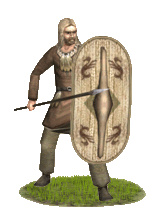 The Druhtiz Habukisku ("Chauci Warband") are local warriors, bound to their druhtinaz (war-leader), and organized into a druhtiz (warband) in his service. Though difficult to control, they are sincere in their desire for glory and plunder, and fight well to secure both. To this end, Druhtiz Habukisku are trained well in the burdahagon ("shield-wall") formation and perform better defensively than their neighbors. The Druhtiz Habukisku ("Chauci Warband") are local warriors, bound to their druhtinaz (war-leader), and organized into a druhtiz (warband) in his service. Though difficult to control, they are sincere in their desire for glory and plunder, and fight well to secure both. To this end, Druhtiz Habukisku are trained well in the burdahagon ("shield-wall") formation and perform better defensively than their neighbors.
Historically, the Habukoz (Chauci), whose name means "Hawks" in their own language, were a populous tribe inhabiting the extreme northwestern shore of Germania. Their warriors often used representations of birds on their clothing and shields. They were experienced sailors and just as often experienced pirates, but were always able to defend their lands with strength and valor.
Druhtiz Herusku (Cherusci Swordsmen)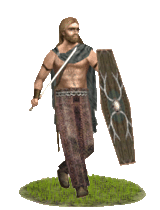 The Druhtiz Herusku ("Cherusci Warband") are fierce and hardy warriors, often serving under the command of an ambitious druhtinaz (king/war-leader). The Druhtiz Herusku can form a very dense shieldwall and are exceptional in defense. Many of their number possess swords and are rightly feared for their ability in melee combat and skirmishing. The Druhtiz Herusku ("Cherusci Warband") are fierce and hardy warriors, often serving under the command of an ambitious druhtinaz (king/war-leader). The Druhtiz Herusku can form a very dense shieldwall and are exceptional in defense. Many of their number possess swords and are rightly feared for their ability in melee combat and skirmishing.
Historically, the Heruskoz, whose name meant "Sword-ish ones" in their own language, were a Germanic tribe who inhabited the Rhine valley and the plains and forests of northwestern Germania. They were frequently at odds or allied with the Romans, as their individual political situation warranted, and made most famous by the Battle of the Teutoburg Forest, whence an army of allied Germanic tribes under the Cherusci war-leader Ermenaz ("Great one," more commonly known in Latin as Arminius) who annihilated three Roman legions commanded by Publius Quinctilius Varus.
This crushing Roman defeat stopped Rome's advance and compelled the empire, after a few more years of generally indecisive campaigning by Germanicus, to withdraw permanently behind the Limes fortification which was built as a consequence of the loss at Teutoburg Forest, to reinforce the German frontier.
Jugunthiz Hattisku (Chatti Club Infantry)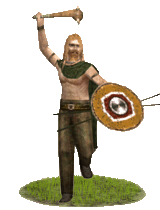 The Jugunthiz Hattisku ("Chatti Youth") is a unit of young and unproven warriors of the Hattoz (Chatti) tribe, who act as a screen and take losses to increase the odds of survival for more valuable "proven" troops (Dugunthiz). The Jugunthiz Hattisku are wild and reckless warriors, their courage and morale is undisputed as they are eager to prove themselves in battle, often to the detriment of the battle's outcome. Their chosen weapon is the cudgel, an appropriate weapon for their particular aim and vicious style of combat, eager to kill quickly and thoroughly. The Jugunthiz Hattisku ("Chatti Youth") is a unit of young and unproven warriors of the Hattoz (Chatti) tribe, who act as a screen and take losses to increase the odds of survival for more valuable "proven" troops (Dugunthiz). The Jugunthiz Hattisku are wild and reckless warriors, their courage and morale is undisputed as they are eager to prove themselves in battle, often to the detriment of the battle's outcome. Their chosen weapon is the cudgel, an appropriate weapon for their particular aim and vicious style of combat, eager to kill quickly and thoroughly.
Historically, the Hattoz (Chatti), which means "Ones who battle" in their own language, were a turbulent tribe who often clashed with the Romans and neighboring people. It was common for their young warriors not to shave their beards or cut their hair until they killed their first opponent in battle, thoroughly demonstrating what their societal expectations were within their tribe. A typical symbol of the battle oath they take is the iron ring worn around their neck which cannot be removed until they have committed man-slaughter, and more gruesomely, self-inflicted scars, ritualized body-art performed as they stand over the body of their fallen enemy.
Dugunthiz Hattisku (Chatti Spearmen)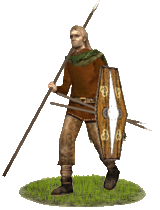 The Dugunthiz Hattisku ("Chatti Proven") is a unit of proud and experienced, "trusted" and "capable" warriors of the Hattoz (Chatti) tribe, steeled by years of constant warfare and "veterans" of numerous conflicts, mostly tribal, but some of a larger scale. These men are hardened for battle and unlikely to flee from conflict, and are trained through long experience to work in close or open formation, and even the burdahagon ("shieldwall"). Their courage and morale is unrefutable as they have "proven" themselves in battle and earned the right to use their gaizaz (spear). The Dugunthiz Hattisku ("Chatti Proven") is a unit of proud and experienced, "trusted" and "capable" warriors of the Hattoz (Chatti) tribe, steeled by years of constant warfare and "veterans" of numerous conflicts, mostly tribal, but some of a larger scale. These men are hardened for battle and unlikely to flee from conflict, and are trained through long experience to work in close or open formation, and even the burdahagon ("shieldwall"). Their courage and morale is unrefutable as they have "proven" themselves in battle and earned the right to use their gaizaz (spear).
Historically, the Hattoz (Chatti), which means "Ones who battle" in their own language, were a turbulent tribe who often clashed with the Romans and neighboring people. It was common for their young warriors not to shave their beards or cut their hair until they killed their first opponent in battle, thoroughly demonstrating what their societal expectations were within their tribe. A typical symbol of the battle oath they take is the iron ring worn around their neck which cannot be removed until they have committed man-slaughter, and more gruesomely, self-inflicted scars, ritualized body-art performed as they stand over the body of their fallen enemy.
Druhtiz Skandzisku (Scandinavian Spearmen)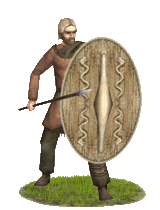 Skándzá (Scandinavia) and Auwjogotánoz (Gotland) are lands with a harsh climate and their people are accustomed to fighting everyday for their own survival. The Druhtiz Skandzisku ("Scandinavian Warband") composed of these tribes is full of fierce and hardy fighters, seeking glory and loot along their route on the war path, but are difficult to control for tactical maneuvering. In warfare it is up to each man to prove his own bravery and worth, so their uniquely savage charge into the enemy enables them to perform slightly better than their neighbors in that respect.
Skándzá (Scandinavia) and Auwjogotánoz (Gotland) are lands with a harsh climate and their people are accustomed to fighting everyday for their own survival. The Druhtiz Skandzisku ("Scandinavian Warband") composed of these tribes is full of fierce and hardy fighters, seeking glory and loot along their route on the war path, but are difficult to control for tactical maneuvering. In warfare it is up to each man to prove his own bravery and worth, so their uniquely savage charge into the enemy enables them to perform slightly better than their neighbors in that respect.
Historically, Scandinavia was also homeland to some of the mainland Germanic tribes. The tribes of the North continued fighting in the druhtiz (warband) style, forming a single armed entity and relying on their individual superiority as warriors to carry the day. Similar tactics are used by many other barbarian peoples, but Germanic warriors use a much denser formation that is far more difficult to break.
Gaizoz Alje (Celto-Germanic Spearmen)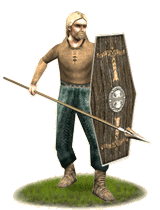 On the borders between Celtic and Germanic territories, the cultures overlap and give rise to troops that are a mesh of both cultures. These spearmen, the Gaizoz Alje ("Foreign Spears") are capable warriors who fight with long shields, javelins, and Celtic longspears that are excellent for killing horses. They throw javelins before charging, and can use their spears to absorb the shock of a cavalry rush. Their skills are a mix of Celtic and Germanic warfare and are a good addition to any army. On the borders between Celtic and Germanic territories, the cultures overlap and give rise to troops that are a mesh of both cultures. These spearmen, the Gaizoz Alje ("Foreign Spears") are capable warriors who fight with long shields, javelins, and Celtic longspears that are excellent for killing horses. They throw javelins before charging, and can use their spears to absorb the shock of a cavalry rush. Their skills are a mix of Celtic and Germanic warfare and are a good addition to any army.
Historically, as Celtic and Germanic cultures fought, traded, and intermarried, their cultures melded, creating unique sub-cultures and mixed tribes, with melds of tactics, weapons, and military philosophies. Such warriors were generally very fierce, and their armies built around infantry. The employ of lengthy spears was common to defeat enemy cavalry, though they could be used to effect against infantry as well. Warriors of this type actually persisted for quite a long time; even up to the fall of Rome, less-Romanized Britons under Anglo-Saxon rule or culture would have been fairly similar troops.
|
 |
|
 |






















|